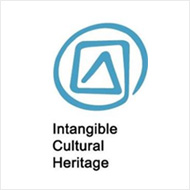- It is practice, representation, expression, knowledge, and skills that generations, groups, or sometimes individuals,
It is practice, representation, expression, knowledge, and skills that generations, groups, or sometimes individuals perceive as part of their cultural heritage, and instruments, objects, artifacts, and cultural spaces related thereto.
Intangible heritage is transmitted from generation to generation
- and promotes respect for cultural diversity and the creativity of mankind by ensuring that groups are recreated constantly in response to the environment, interacting with nature and history, and ensuring that they have an identity and continuity.
UNESCO
The official name of UNESCO is United Nations Educational, Scientific, and Cultural Organization, abbreviated as UNESCO. Representatives of the UNESCO preparatory committee from 37 countries gathered in London, UK on November 16, 1945, and adopted the “UNESCO Charter” to establish UNESCO to contribute to world peace through international cooperation in education, science, and culture in the wake of World War II.
UNESCO’s main objective is to promote international cooperation through education, science, and culture, and to contribute to peace and sustainable development while improving universal respect for justice, law, human rights, and fundamental freedoms.

Functions of UNESCO
1. Laboratory of Idea - Predict future key issues and identify relevant strategies and policies
2. Standard Setter - Establish relevant norms by clarifying major moral, normative, and intellectual issues
3. Clearing House - Collect and distribute information and knowledge precedents, discovery and testing of innovative activities
4. Capacity Builder in Member States - Develop human and institutional capacity of member countries
5. Catalyst for international cooperation - Serve as a catalyst for development cooperation
Intangible Cultural Heritage
One of UNESCO’s main activities, the cultural sector, recognizes the importance of all heritage including the tangible heritage and intangible heritage of mankind and emphasizes cultural diversity for the sustainable development of mankind. In 2003, UNESCO adopted the Convention for the Safeguarding of the Intangible Cultural Heritage, contributing to the promotion of cultural diversity.
-
Definition of Intangible Cultural Heritage (Article 2 of the Convention)
-
Examples of Intangible Cultural Heritage
- Oral traditions and expressions, including language as a vehicle of ICH
- iconPerforming arts
- iconSocial practices, rituals and festive events
- iconTraditional craftsmanship
Convention for the Safeguarding of the Intangible Cultural Heritage
The Convention on the Protection of Intangible Cultural Heritage entered on October 17, 2003 adopted the urgent safeguarding list and representative list entry system, and integrated heritage declared as ‘Masterpieces of the Oral and Intangible Heritage of Humanity’ into the ‘Representative List of Intangible Cultural Heritage of Humanity’.
In addition, UNESCO sought to expand the participation of various entities such as NGOs, communities, experts, professional centers, and research institutes in the safeguarding of intangible heritage based on the convention adopted, established the intergovernmental committee and the intangible heritage fund for implementation of the convention to request national reports on safeguarding intangible heritages to contribute to, and raise awareness of intangible heritage protection.
In addition, UNESCO sought to expand the participation of various entities such as NGOs, communities, experts, professional centers, and research institutes in the safeguarding of intangible heritage based on the convention adopted, established the intergovernmental committee and the intangible heritage fund for implementation of the convention to request national reports on safeguarding intangible heritages to contribute to, and raise awareness of intangible heritage protection.

※ This is an excerpt from the “Overview of UNESCO 2015” issued by the Ministry of Foreign Affairs.





